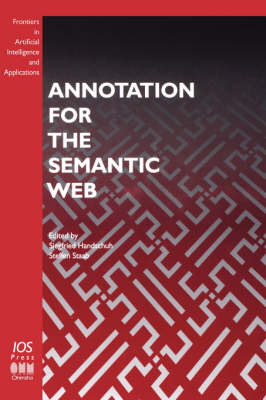
Annotation for the Semantic Web
Seiten
2003
IOS Press,US (Verlag)
978-1-58603-345-3 (ISBN)
IOS Press,US (Verlag)
978-1-58603-345-3 (ISBN)
- Keine Verlagsinformationen verfügbar
- Artikel merken
A core technology for making the Semantic Web happen, but also to leverage application areas like Knowledge Management and E-Business, is the field of Semantic Annotation, which turns human-understandable content into a machine understandable form. This book reports on the broad range of technologies that are used to achieve this translation.
The Semantic Web aims at machine agents that thrive on explicitly specified semantics of content in order to search, filter, condense, or negotiate knowledge for their human users. A core technology for making the Semantic Web happen, but also to leverage application areas like Knowledge Management and E-Business, is the field of Semantic Annotation, which turns human-understandable content into a machine understandable form. This book reports on the broad range of technologies that are used to achieve this translation and nourish 3rd millennium applications. The book starts with a survey of the oldest semantic annotations, viz. indexing of publications in libraries. It continues with several techniques for the explicit construction of semantic annotations, including approaches for collaboration and Semantic Web metadata. One of the major means for improving the semantic annotation task is information extraction and much can be learned from the semantic tagging of linguistic corpora. In particular, information extraction is gaining prominence for automating the formerly purely manual annotation task - at least to some extent.An important subclass of information extraction tasks is the goal-oriented extraction of content from HTML and / or XML resources.
The Semantic Web aims at machine agents that thrive on explicitly specified semantics of content in order to search, filter, condense, or negotiate knowledge for their human users. A core technology for making the Semantic Web happen, but also to leverage application areas like Knowledge Management and E-Business, is the field of Semantic Annotation, which turns human-understandable content into a machine understandable form. This book reports on the broad range of technologies that are used to achieve this translation and nourish 3rd millennium applications. The book starts with a survey of the oldest semantic annotations, viz. indexing of publications in libraries. It continues with several techniques for the explicit construction of semantic annotations, including approaches for collaboration and Semantic Web metadata. One of the major means for improving the semantic annotation task is information extraction and much can be learned from the semantic tagging of linguistic corpora. In particular, information extraction is gaining prominence for automating the formerly purely manual annotation task - at least to some extent.An important subclass of information extraction tasks is the goal-oriented extraction of content from HTML and / or XML resources.
| Erscheint lt. Verlag | 6.1.2003 |
|---|---|
| Reihe/Serie | Frontiers in Artificial Intelligence and Applications ; v. 96 |
| Zusatzinfo | 1, black & white illustrations |
| Verlagsort | Amsterdam |
| Sprache | englisch |
| Gewicht | 514 g |
| Themenwelt | Informatik ► Theorie / Studium ► Kryptologie |
| Informatik ► Theorie / Studium ► Künstliche Intelligenz / Robotik | |
| Mathematik / Informatik ► Informatik ► Web / Internet | |
| ISBN-10 | 1-58603-345-X / 158603345X |
| ISBN-13 | 978-1-58603-345-3 / 9781586033453 |
| Zustand | Neuware |
| Haben Sie eine Frage zum Produkt? |
Mehr entdecken
aus dem Bereich
aus dem Bereich
Geschichte, Techniken, Anwendungen
Buch | Softcover (2022)
C.H.Beck (Verlag)
CHF 13,90
Die faszinierende Geschichte der Verschlüsselung
Buch | Softcover (2022)
Springer (Verlag)
CHF 48,95


